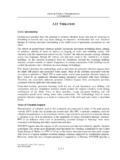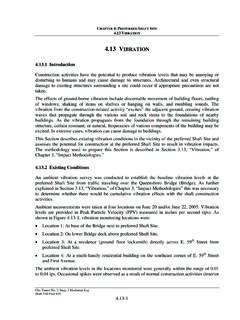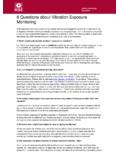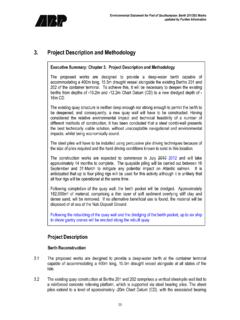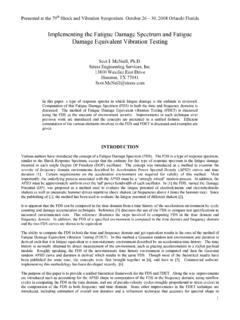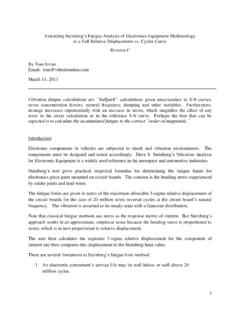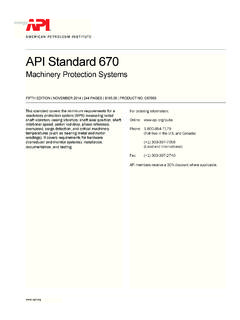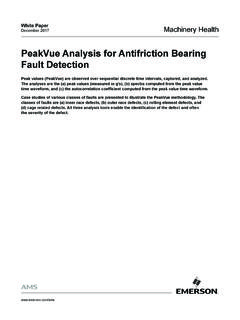Transcription of DETERMINING THE ROOT CAUSES OF SUBSYNCHRONOUS …
1 DETERMINING THE root CAUSES OF SUBSYNCHRONOUS . INSTABILITY PROBLEMS IN TWO CENTRIFUGAL COMPRESSORS. by Ed Wilcox CVO Rotating Equipment Team Lead Lyondell/Equistar Channelview, Texas and David P. O'Brien Principal Reliability Engineer Equistar Chemicals, LP. Clinton, Iowa The first problem occurred with a propylene compressor in a Gulf Ed Wilcox is the CVO Rotating Equipment Coast chemical plant that had experienced high journal bearing tem- Team Lead with Lyondell/Equistar, in peratures for several years. A modified bearing was installed to Channelview, Texas. He is responsible for alleviate the temperature problem; however, a large SUBSYNCHRONOUS troubleshooting, repair, and condition moni- vibration appeared after the new bearings were installed.
2 A lateral toring of rotating equipment at both the stability analysis showed that the compressor with the modified Lyondell and Equistar facilities. Prior to bearings was very stable with the aerodynamic destabilizing effects this, Mr. Wilcox worked for more than 10 predicted by the Alford and/or Wachel equation. A comparison years with Conoco and Citgo as a Rotating analysis was made of the stability predicted with the original bearings Equipment Engineer. He has authored (which were stable) as well as the modified bearings (which were several papers in the areas of rotordynamics, not). This allowed the user to determine the magnitude of the desta- vibration analysis, and performance testing.
3 Bilizing forces present in the compressor and design a new bearing Mr. Wilcox has a BSME degree from the University of Missouri- that was both stable and would operate at an acceptable temperature. Rolla, and an MSME degree from Oklahoma State University. He The new bearing was installed and the compressor has operated has also done postgraduate work at the Georgia Institute of without the SUBSYNCHRONOUS vibration for the past year and a half. Technology in the areas of lubrication, rotordynamics, and The second problem occurred with a very similar ethylene com- vibration . He is a vibration Institute Level III vibration Specialist pressor in a Midwest ethylene plant.
4 This compressor had operated and a registered Professional Engineer in the State of Oklahoma. for over two years after an overhaul with low vibration . Then a SUBSYNCHRONOUS vibration appeared that was very erratic, but was slowly increasing in amplitude over time. To solve the problem, a David P. O'Brien is a Principal Reliability rotordynamic analysis was performed that suggested that replacing Engineer with Equistar Chemicals, LP, in the bearing would solve the stability problem. However, compari- Clinton, Iowa. He has more than 10 years of son between the measured field vibration and the rotordynamic rotating equipment experience in machinery model did not agree on all points.
5 A more indepth look at the com- engineering, mechanical maintenance, pressor revealed that the increase in SUBSYNCHRONOUS vibration was vibration analysis, troubleshooting, and reli- tracking very closely with the balance line differential pressure. ability improvements. This has included This fact, along with the characteristics of the balance piston seal, primary responsibility for turbomachinery suggested that a bearing change alone may not completely address overhauls, repairs, and upgrades specifi- the problem. A new balance piston seal was designed to reduce its cally to process (including dry gas) seals, destabilizing effects on the rotor.
6 The compressor was inspected labyrinth (including abradable) seals, bear- during the next scheduled downtime to determine the cause of the ings, couplings, and other components. Along with his experience at high vibration and install the new balance piston seal and bearings. Equistar, Mr. O'Brien was a Senior Engineer for Custom Bearing Examination of the internals revealed a large seal rub in the com- Corporation, in Wellsville, New York, working with abradable seals, pressor, but at the dry gas seals, not the balance piston. The rub was fluid film bearings, and other rotating equipment components.
7 Addressed and the SUBSYNCHRONOUS vibration was eliminated. While Mr. O'Brien received his degree (Mechanical Engineering) the exact source of the destabilizing force was not correctly guessed before disassembly, the indepth rotordynamic analysis from Iowa State University, and is a registered Professional Engineer did reveal that there was a large destabilizing force in the com- in the State of Iowa. He chairs the Equistar Rotating Equipment pressor, and a bearing change alone would not eliminate the Best Practice Team and is a member of the vibration Institute. vibration . The compressor has been operating without the subsyn- chronous problem for the past year since the modification.
8 ABSTRACT CASE STUDY 1 GULF COAST. This paper discusses the rotordynamic instability problems PROPYLENE EXPORT COMPRESSOR. experienced with two separate centrifugal compressors. While the root CAUSES of the instabilities are very different, the analysis Background methodology of reconciling the rotordynamic model with The first compressor is a horizontally split, eight-stage, inter- measured vibration data was the same. cooled compressor in a Gulf Coast chemical plant that pumps 9. 10 PROCEEDINGS OF THE THIRTY-SECOND TURBOMACHINERY SYMPOSIUM 2003. propylene gas from 30 to 280 psig. The compressor operates between 10,000 and 12,500 rpm and is driven by a 3000 hp turbine through a speed-increasing gearbox.
9 The original bearing design was a five-pad load-on-pad (LOP) bearing with center pivots and relatively tight clearance ( to inch on a 3 inch journal). In October of 2000, the compressor was overhauled as part of a normal unit turnaround. After the overhaul, the radial bearing tem- peratures were excessively high (~220 F) and would rapidly spike to over 300 F at times. This compressor had experienced high bearing temperatures in the past as well. To solve the problem, the bearing design was changed to a load-between-pad (LBP) design with offset/spherical pivots and higher radial clearance (Figure 1).
10 The analysis of the new bearing design predicted that the bearing temperature would be lowered by at least 25 F. Likewise, the rotor- dynamic analysis of the compressor with the new bearing predicted Figure 3. Predicted Coupling End Synchronous Response with that the synchronous vibration would be low with the new bearings New Bearings. (Figures 2 and 3). A lateral stability analysis was not performed by the contractor, mainly because the sole objective of the bearing design was to lower the bearing temperature, and because the vibration of the compressor had always been so low. Likewise, a stability analysis had been performed during the conversion to dry gas seals in 1994, which showed that the compressor rotor was very stable (Figure 4).

